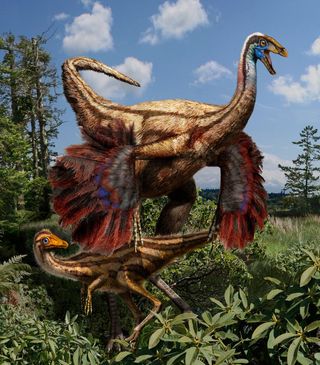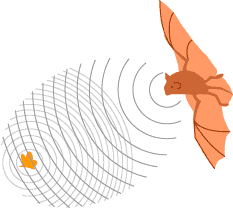Explain How Different Exaptations Contributed to Flight
Different combinations of genesalleles exist to cause cell size to vary such that each species has a typical range of cell size and the species - distributed among various genera -. Later feathers became longer and stiffer allowing for gliding and then for flight.

Exaptation And Innovation Ppt Download
These changes require explanation by natural selection Wakefield in press.

. Jun Kitano Ryo Kakioka Asano Ishikawa Atsushi Toyoda Makoto Kusakabe Differences in the contributions of sex linkage and androgen regulation to sexbiased gene expression in juvenile and adult sticklebacks Journal of Evolutionary Biology 33 no8 8 Jul 2020. In conjunction with previous work. Up to 10 cash back While feathers may be understood as exaptations for flight under the assumption that they originally evolved for thermoregulation the various subsequent modifications of feathers for flight are secondary adaptations thus making certain features of the feathers engineering adaptations themselves Gould and Vrba 1982 p.
Bats they are the only mammals with the ability to fly. Exaptation cooption and preadaptation are related terms referring to shifts in the function of a trait during evolution. The notion that a birds existing mechanism that enable it to perform the new feathers originally were designed for thermal regulation exapted function.
Because of the complexity of the human brain most. The study of flights evolutionary origins is also of general interest. The de- velopment of large contour feathers and their arrangement on the arm arise as adaptations for insect catching and become exaptations for flight.
A birds wing includes feathers which are outgrowths of the skin along the whole length of the forelimb arm. By recruiting genes from sources originally unrelated to vision exaptation has allowed for sudden and critical. Interest in exaptation relates to both the process and product of evolution.
Exaptations are common in both anatomy and behaviour. Exaptations almost always involve rather than for flying for example may help to explain structural changes that enable the preexisting mechanism some of its current features that do not seem to contribute designed for another. How do Exaptations differ from Adaptations.
Bird feathers are a classic example. Which of the following phrases best describes the relationship of the. Birds have a strong but a lightweight framework of bones.
NPS PhotoPatricia Simpson The flashy pink of a male Annas Hummingbird Calypte anna gorget helps them to garner the attention of females. These unique traits probably act as important exaptations that facilitate high-altitude flight. Initially these may have evolved for temperature.
Exaptations are common in both anatomy and behavior. Apart from their wing-modified hands they have developed other adaptations for example a very sophisticated. This is achieved by the fusion and elimination of some bones while hollowing the remaining.
National Geographic explains how certain adaptations called exaptations can develop for one purpose and later be used for another such as bird feathers created for warmth and eventually used for flight. Over the aeons birds have evolved not only wings but many other adaptations that help them to fly. Adaptations that develop in response to one challenge sometimes help with or become co-opted for another.
Animals capable of flight their adaptations are different from that of the birds themselves. Birds are thought to be capable of higher ventilation rates than mammals in hypoxia. The process that creates complex traits and the product that may be imperfectly designed.
Term exaptation becomes a crucial concept for an evolu-. The decline in arterial P o 2 hypoxemia drives the increase in breathing in response to environmental hypoxia but CO 2 excretion increases as a secondary consequence 42. Feathers were probably first adaptations for tactile sense or regulating temperature.
Exaptations are adaptations that have undergone a major change in function. Wings and flight is thus a key to understanding this diversification. For example a trait can evolve because it served one particular function but subsequently it may come to serve another.
Mammals trained to live in aquatic environments both in fresh and salt water. Pterosaurs are extinct flying reptiles whose membranous wings were supported by one greatly elongated finger. Birds fly because parts like feathers popped into existence for no reason but later were found useful for flight.
An adaptation is any feature that promotes fitness and was built by selection for its current role. Mantling behavior uses wings that arose as an adaptation for flight. This phenomenon has been called exaptation an alternative to adaptation.
Our findings reveal that developing chukars Alectoris chukar with rudimentary flight apparatuses acquire an avian flight stroke early in ontogeny initially by using their wings and legs cooperatively and as they acquire flight capacity counteracting ontogenetic increases in aerodynamic output with greater skeletal channelization. Of the human skills are exaptations and in his opinion the. Some bones of the pelvic girdle and vertebrae are fused together.
Other adaptations termed vestigial become useless but remain with the organism such as the non-functioning leg bones still found in dolphins. Thus the basic design of feathers is an adaptation for thermoregulation and lat- er an exaptation for catching insects. Under the headline Great Exaptations the Santa Fe Institute is celebrating a new paper in Nature by Aditya Barve and Andreas Wagner.
The specialized flight feathers of owls on the other hand are fringed for silent flight making owls nearly impossible to detect as they swoop down upon prey. Initially these evolved for temperature regulation but later were adapted for flight. Is that any way to explain the complex adaptations in life.
Selection is required to explain the structural changes in an existing mechanism that enable it to perform the new exapted function. Feathers were originally an Adaption for insulation became an Exaptation for flight. Bird feathers are a classic example.
Four elongated fingers support most of the membrane that makes up a bats wing. Flight represents a major innovation that has evolved independently in several different animal groups. Exaptations almost always involve structural changes that enable the preexisting mechanism designed for another function to perform the new function.
Sometimes evolution puts a trait to a new use for instance feathers evolved before flight. Such traits are called exaptations.

Exaptation Taxonomy Biological And Technological 20 Download Table

Pdf How Exaptations Facilitated Photosensory Evolution Seeing The Light By Accident

What Is Adaptation Adaptation Comes From Ad To Or Toward And Aptus A Fit Evolutionary Context Genetically Based Genetically Based Change In Ppt Download

Pdf Technological Exaptation A Narrative Approach

Exaptation How Evolution Uses What S Available Live Science

Definition Of Aptation Adaptation And Exaptation This Figure Is Download Scientific Diagram

Pdf The Great Exaptation Around A Fundamental Idea Of Evolutionary Psychology

Definition Of Aptation Adaptation And Exaptation This Figure Is Download Scientific Diagram

No comments for "Explain How Different Exaptations Contributed to Flight"
Post a Comment